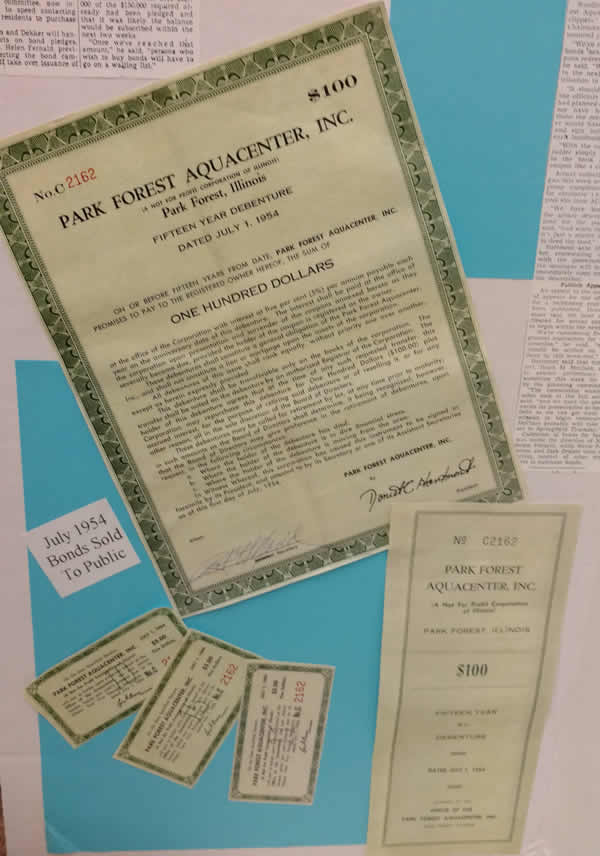
Park Forest, IL-(ENEWSPF)- Park Forest Historical Society is celebrating the 70th Anniversary of Park Forest in 2018-2019. The 1950s Park Forest House Museum is featuring displays of documents, articles, and photographs on the planning and building of Park Forest, from its inception in 1946.
Also, there is a display on the history of the Park Forest Aqua Center which was the largest pool complex in Illinois when it was opened in 1955. Both exhibits will run into August 2019.
The museum is at 227 Monee Road, inside St. Mary’s Catholic Church in the last two rooms at the far end of the building. It is open Wednesday and Saturday 1-3:30 p.m. or for small groups by appointment. An admission/donation of $5 for adults is required.
Kids 12 and under are free with an adult.
Important dates in Park Forest History include October 28, 1946, when American Community Builders announced Park Forest would be built. The original Plan of Town was submitted to the Federal Housing Authority on November 26, 1946. Groundbreaking and construction of 3010 rental townhomes began on October 28, 1947. All 3010 are finished by late October 1949.
On August 30, 1948, the first three families moved in—Ross Delues, Bill Heckmans, and Manuel Kaplans. Philip Klutznick’s rental was furnished already but his family did not move in for a few more weeks. Mr. Klutznick was the president of developers, American Community Builders.
On November 27, 1948, tenants in residence and those who had signed leases were invited to a tent meeting. The tenants were invited to vote to incorporate as a village before the population was so large that they had to incorporate as a city and have a Mayor/Alderman form of government. Committees formed at this meeting set the tone for Park Forest’s heavy civic involvement. On February 1, 1949, Park Forest was incorporated. By encouraging their tenants to vote to incorporate, American Community Builders allowed their tenants to have governance over them when they still had 15 years of building the village they were developing. This was a revolutionary approach.
The 1950s Park Forest House Museum represents an original rental townhome, furnished as it might have been from 1948-1953, the first five years of the village. Park Forest is the first fully-planned, post-World War II suburb, built to give preference to returning World War II veterans. It was the subject of William H. Whyte’s, “Organization Man,” and of Gregory Randall’s, “America’s Original GI Town.” Originally the 50th Anniversary House Museum, it began in September 1998 as a two-month temporary exhibit in an original rental townhome. It had been housed in three different rental units, but since September 2015 has been in the former St. Mary’s Catholic School. The museum celebrated its 20th Anniversary last September.
The museum also features an exhibit on Judaism in Park Forest. Several of the partners of American Community Builders were Jewish and stood up to the prevailing, “Gentlemen’s Agreement” of covenants against Jewish residents. Partner Sam Beber, in his youth, had formed AZA, which has become an international organization for young Jewish men. President Philip Klutznick later became the leader of B’nai B’rith International.
A museum visit is a great way to get acquainted with Park Forest Illinois’ unique history. It is a nostalgic trip down Memory Lane for anyone who lived in the 1950s or 1960s, or for those interested in that period, and offers a great destination for a “staycation.” Visitors are encouraged to open drawers, cupboards, and closets to discover period treasures inside. Contents of the house, furnished as though a young veteran and his family of small children occupy it, include dolls, toys, dollhouses, children’s and adult books, dishes, serving pieces, furniture, and clothing from the period. When is the last time you said “Hello” to Howdy Doody, Zippy the chimp, or revisited your metal dollhouse?
One room represents a classroom in the first school, Forest Boulevard School, which was set up in a row of townhomes. The museum is decorated seasonally for vintage holiday exhibits.
A guide will tell village history, and social and fashion trends of the era. A self-guided tour script is available. The Park Forest Historical Society is eagerly seeking more volunteers to show the museum. Contact Jane Nicoll, Museum Director at 708-481-4252 for information and training.
Park Forest Historical Society also operates the Local History Collection and Archive. In the museum, visitors or researchers will find more than 270 subject files on Park Forest. Oral histories exist of early residents telling their own stories of how Park Forest was settled. Several of these are on Illinois Digital Archives, in “Park Forest: An Illinois Planned Community” which can be accessed through the Society’s website, www.parkforesthistory.org.
The Archive is housed in a separate room at St. Mary’s and is open most Fridays from 10-12; or by appointment. A call to Jane Nicoll, Archivist, 708-481-4252 is recommended before coming.








